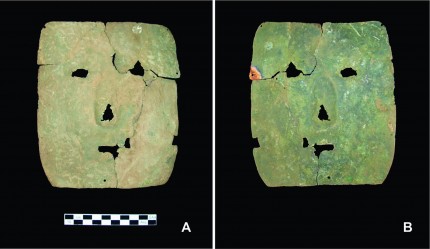The Peruvian Andes have long been believed to be the origin of metallurgy in pre-Hispanic America, but an ancient copper mask discovered in what is today northwest Argentina indicates that copper metalwork was developing in the southern Andes even earlier than in the central Andes. The mask was discovered in April of 2005 in the village of La Quebrada in the Cajón Valley. The villagers found it poking out of the ground after the rainy season and notified an archaeological team that had been working in the area since the year before. Human skeletal remains near the mask were also exposed by the rains.
Thanks to the diligence and responsible actions of the villagers, archaeologists were afforded the rare opportunity to excavate the find in its original context. They found that it was a burial, as the human bones might suggest, located on a high point of the landscape near the archaeological site of Bordo Marcial. (Bordo Marcial is an important early agricultural settlement from the Formative period dating to around 1800 – 1900 years before the present.) At least 14 people were buried in this funerary context, adult men and women and children of different ages. There were no intact articulated skeletons; the bones were mixed up together.
The mask was found placed on top of the bones at the northern corner of the burial. The copper had stained several of the bones green, which confirmed the mask and at least some of the remains were buried together. The west side of the tomb is bordered by a stone wall. On the other side of a second stone wall next to it, the remains of a child between eight and 12 years old at time of death were found with a small copper pendant.
Radiocarbon dating found that the green bones from the corner of the burial date to 1377–1010 B.C. The bones of the child date to 1414–1087 B.C., so the group burial and the child burial date to the same time. This was an important transitional period in the region, when the population, still spread out in small groups, shifted from the hunter-gatherers constantly on the move to early farming settlements.

The mask is seven inches high, six inches wide and just one millimeter thick. Holes representing eyes, a nose and a mouth were punched through from the back of a mask and nine small circular holes were made on each side, at the top corners and in the middle, bottom and top margins. Archaeologists believe strings may have been tied through these small holes so the mask could be worn, of they may have connected it to a larger, multi-part artifact the rest of which has decayed over time.
A layer of corrosion covers the mask, which for its own preservation was not removed by the archaeological team. Analysis of the metal found that it was made of pure copper, with no arsenic or tin present that would indicate the intentional creation of bronze. Microscopic examination identified recrystallisation grains and annealing twins, typical features of copper worked by a technique that alternates cold hammering and reheating. The corrosion layer made it impossible to determined anything else about the metallurgic process used to create the mask.
Even though there is extensive archaeological evidence of early metalwork developing in the Peruvian Andes and spreading to other areas of Central and South America from there, there is very little evidence of early copper work in the Central Andean region, only slag associated with copper smelting and a few fragments of laminated copper. These are roughly contemporaneous with the Bordo Macial mask. None of those copper traces are evidence of the use of copper in the creation of an actual artifact. The mask bears that distinction.
This mask is the oldest intentionally shaped copper object recovered from the Andes, with an associated radiocarbon date that suggests that metalworking technology did indeed originate in more than one region of the Andes.
I hope they paid the villagers ‘tips’ or such for the find. It’s really the only way to compete with illegal work.
It’s mine!